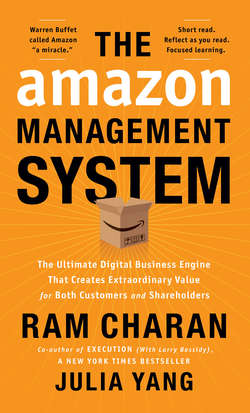Читать книгу The Amazon Management System - Ram Charan - Страница 36
На сайте Литреса книга снята с продажи.
Earnings vs. cash generation
ОглавлениеMany people have been baffled by Amazon, which has long been on the verge of barely breakeven, but has enjoyed an unbelievable leap forward in terms of market valuation.
Those who assumed that Amazon is unprofitable or makes little profits are unequivocally mistaken, because the most relevant metric in the digital age is cash earnings per share, not EPS (earnings per share). Unlike the fixed asset investment by traditional companies that can be categorized as CapEx (capital expenditure), and thus depreciated over a multi-year timeframe, many of the investments into the digital tools, systems, and platforms can only be categorized as OpEx (operational expenditure), and thus listed as expenses of the current year, thus lowering the net earnings. Such investments are essential to achieve 25% per year growth.
Amazon’s track record disproves this misunderstanding and removes every single shred of delusion that those digital giants will falter because they are not making money in terms of net income. When they achieve appropriate scale, these companies are massive cash machines, making enormous cash.
Why this focus on cash flows, especially gross margin cash generation? As a Wall Street veteran, Bezos fully understands that “a share of stock is a share of a company’s future cash flows, and, as a result, cash flows more than any other single variable seem to do the best job of explaining a company’s stock price over the long term.”17
Bezos has walked the talk. And indeed the capital market has rewarded him, in a generous and righteous way.
Let’s do the math together. In 2018, Amazon made $232.9Bn revenue. At a gross margin of 40.25%, this translates into $93.7Bn gross margin cash generation in one year alone. From the operating cash flow point of view, Amazon generated $30.7Bn in net cash from operations in 2018.
However, instead of leaving this enormous cash as profits on its financial statement, Amazon has been consistently and massively investing gross margin cash into technology ($28.8 billion in R and D expenses), platform and infrastructure ($13.4Bn in capital expenditure) to fund its exponentially fast scaling.18
Over a 7-year time period from 2011 to 2017, Amazon invested over $150 billion worldwide in fulfillment networks, transportation capabilities, and technology infrastructure, including AWS data centers.19
Why? From our earlier analysis, you will know this is deliberately done in the spirit of scale and speed, i.e., to drive continued growth in the number of customers, customer data, improvement of end-to-end customer experience, and to sustain large-scale barriers and reinforce unmatchable competitive advantages in the platform, the infrastructure (the last mile delivery) and the digital core competence.
Viewed in this light, one can clearly see the consistent underlying logic that cuts through Amazon’s 25-year journey—one that is amazing while at the same time seemingly confusing and marked by continuous exploration and expansion. In fact, no matter what Amazon did, does or will do, it has and will always derive from its core principles: customer obsession, relentless drive to invent, long-term thinking, and prioritization of cash generation. Amazon’s remarkable consistency to these principles from Day 1 has positioned the company to create an historic variety of businesses at a global scale. Few people recognize the tight underlying linkage among all pieces as part of a holistic self-reinforcing dynamic model that is able to capitalize the new concepts of platform, ecosystem, and infrastructure in the digital age, continuously strengthen the digital core competence, drastically defy traditional laws of diminishing returns, and reliably delivers enormous cash generation and shareholder value creation.
